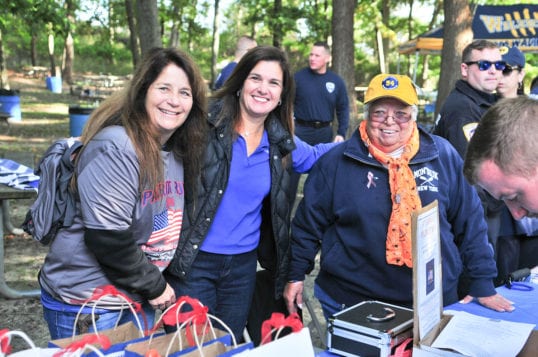1 of 26

Lexi Smith and Joey Krause in the fourth annual Patriot Run in memory of Thomas Cutinella, that was held Oct. 14 at Wildwood State Park in Wading River. Photo by Bill Landon

Kevin Krause and Joey Krause in the fourth annual Patriot Run in memory of Thomas Cutinella, that was held Oct. 14 at Wildwood State Park in Wading River. Photo by Bill Landon

Kevin Krause was first across the finish line in the 30 and older group in the fourth annual Patriot Run in memory of Thomas Cutinella, held Oct. 14 at Wildwood State Park in Wading River. Photo by Bill Landon

Joey Krause was first across the finish line in the 13-19 year old age group in the fourth annual Patriot Run in memory of Thomas Cutinella, held Oct. 14 at Wildwood State Park in Wading River. Photo by Bill Landon

Chef Pierre toiled at the grill preparing lunch for all those running the fourth annual Patriot Run in memory of Thomas Cutinella, that was held Oct. 14 at Wildwood State Park in Wading River. Photo by Bill Landon

Race winners and Frank and Kelli Cutinella, Thomas’ parents (blue shirts), after the running of the 4th annual Patriot Run in memory of their son was held Oct. 14 at Wildwood State Park in Wading River. Photo by Bill Landon

Scenes from the fourth annual Patriot Run in memory of Thomas Cutinella, held Oct. 14 at Wildwood State Park in Wading River. Photo by Bill Landon

Frank and Kelli Cutinella, center, pose with Suffolk County Legislator Sarah Anker at the fourth annual Patriot Run in memory of their son Thomas Cutinella, held Oct. 14 at Wildwood State Park in Wading River. Photo by Bill Landon

Lunch for all after the running of the fourth annual Patriot Run in memory of Thomas Cutinella, that was held Oct. 14 at Wildwood State Park in Wading River. Photo by Bill Landon

Scenes from the fourth annual Patriot Run in memory of Thomas Cutinella, held Oct. 14 at Wildwood State Park in Wading River. Photo by Bill Landon

Lexi Smith was first across the finish line in the 13-19 year age group in the fourth annual Patriot Run in memory of Thomas Cutinella, held Oct. 14 at Wildwood State Park in Wading River. Photo by Bill Landon

The running of the fourth annual Patriot Run in memory of Thomas Cutinella, held Oct. 14 at Wildwood State Park in Wading River. Photo by Bill Landon

The running of the fourth annual Patriot Run in memory of Thomas Cutinella, was held Oct. 14 at Wildwood State Park in Wading River. Photo by Bill Landon

The running of the fourth annual Patriot Run in memory of Thomas Cutinella, was held Oct. 14 at Wildwood State Park in Wading River. Photo by Bill Landon

The running of the fourth annual Patriot Run in memory of Thomas Cutinella, was held Oct. 14 at Wildwood State Park in Wading River. Photo by Bill Landon

The running of the fourth annual Patriot Run in memory of Thomas Cutinella, was held Oct. 14 at Wildwood State Park in Wading River. Photo by Bill Landon

The running of the fourth annual Patriot Run in memory of Thomas Cutinella, was held Oct. 14 at Wildwood State Park in Wading River. Photo by Bill Landon

The running of the fourth annual Patriot Run in memory of Thomas Cutinella, was held Oct. 14 at Wildwood State Park in Wading River. Photo by Bill Landon

The running of the fourth annual Patriot Run in memory of Thomas Cutinella, was held Oct. 14 at Wildwood State Park in Wading River. Photo by Bill Landon

The running of the fourth annual Patriot Run in memory of Thomas Cutinella, was held Oct. 14 at Wildwood State Park in Wading River. Photo by Bill Landon

The running of the fourth annual Patriot Run in memory of Thomas Cutinella, was held Oct. 14 at Wildwood State Park in Wading River. Photo by Bill Landon

The running of the fourth annual Patriot Run in memory of Thomas Cutinella, was held Oct. 14 at Wildwood State Park in Wading River. Photo by Bill Landon

The running of the fourth annual Patriot Run in memory of Thomas Cutinella, was held Oct. 14 at Wildwood State Park in Wading River. Photo by Bill Landon

The running of the fourth annual Patriot Run in memory of Thomas Cutinella, was held Oct. 14 at Wildwood State Park in Wading River. Photo by Bill Landon
By Bill Landon
The 4th annual Patriot Run hosted by the Thomas Cutinella Memorial Foundation was held Sunday, Oct. 14, at Wildwood State Park in Wading River. The foundation is a nonprofit started in memory of Thomas by his parents — Frank and Kelli Cutinella — with the goal of improving awareness for football-related head injuries. Thomas was a Shoreham-Wading River football player killed as a result of an on-field collision in 2014. The race is held in his memory every year.













































































